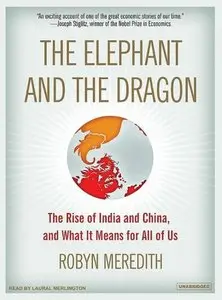Robyn Meredith, "The Elephant and the Dragon: The Rise of India and China, and What It Means for All of Us"
Tantor Media | 2007 | ISBN: 1400154855 | Audio CD | mp3 | 160 MB
Tantor Media | 2007 | ISBN: 1400154855 | Audio CD | mp3 | 160 MB
The Elephant and the Dragon takes a compelling look at the major changes in store as America faces increasing competition from two emerging Asian giants, India and China. In it, Robyn Meredith tells how these two Asian nations, each with more than a billion people, have spurred a new "gold rush," and what this will mean for the rest of the world.
Summary: Studded with Statistics
Rating: 5
The innumerable statistics in this book shows the author's deep involvement in the economic development of India and China. It is a must read for all those who have a stake in the global economic activity. Very interesting to read. When reading some chapters one might loose track of what the subject matter of a chapter is.
Summary: The Word will be Flattened
Rating: 4
In its book, "The World is Flat" Thom Friedman makes a comment he told his daughters: "Do your homework, or else there are hungry workers in China and India who will take your future job from you." The Elephant and the Dragon goes into great detail about how that actually came about. It is a great analysis of the role that India and China have played for the last 10 centuries and what this next century will most likely bring. Despite both countries being called "emerging markets," they are as different as … well, the Elephant and the Dragon. India is trully an Elephant, slow and rambling, with a very long memory and idiosincratic trunk (its IT and service sector) that is still in great contrast to the rest of the country that still lacks have electricity and running water for 40% of its billion people. China, on the other hand is a phoenix rizen from the ashes of the Cultural Revolution with little memory or history, fueled by the firery breath (and breadth) of manufacturing by the ambitious central planning. Robyn's in-depth analysis outlines not just the opportunities but the obstacles that each of the countries will face in the next century. I highly recommend it.
Summary: Global Growth Challenges with the Rise of India and China
Rating: 5
Great read to understand the "tectonic" shifts going on in the global economy (term used in the introduction of the book). Ms. Meredith does a great job of doing a side by side comparison of the worlds two largest growth engines - India and China, and uses the animal metaphors to describe the two different paths being taken. The book focuses on the economic development and financial consequences, but also touches on some of the political and environmental dependencies of such.
The growth of China into the worlds manufacturing center is fully developed, and provides a stark reminder of the wage differential between China and the West (dollars per day versus per hour). Continually the reader is reminded that China remains a communist country, and that central planning rules the day. Near the end of the text, Meredith touches on the subject of the yuan-dollar exchange rate issue, and describes the dynamics impacting both sides. It would have been good to hear more on this subject as I don't fully understand both sides of the argument, and like many things find it poorly covered in the MSM.
India's rise as the worlds back-office is well detailed, as well as how it is progressing in reforming it's economy under the structure of a democracy. It isn't a rosy story as the topics of poverty and illiteracy are covered, although Mr. Meredith reminds the reader that hundreds of millions have been lifted up as part of the economic gains.
There's also great perspective inserted throughout the book that while the rise of India and China has been sudden, it is entirely consistent with global economic history as these two countries were global superpowers in prior centuries. It was a throwback to school lessons I had years ago to hear references to the spice routes, and other exotic imports from the 16th century.
I appreciated the closing chapter (A Catalyst for Competitiveness) that recommended where the country should focus its efforts on - innovation, education, reduced consumption. While this recommendation isn't novel, it provided good closure to the story that was a difficult message to consume as a parent and an American worker. Clearly our country has it's work cut out for it.
part1
part2
Not all books on AvaxHome appear on the homepage.
In order not to miss many of them follow ebooks section (see top of each page on AH)
and visit my blog too :)
In order not to miss many of them follow ebooks section (see top of each page on AH)
and visit my blog too :)
NO MIRRORS according to the rules



